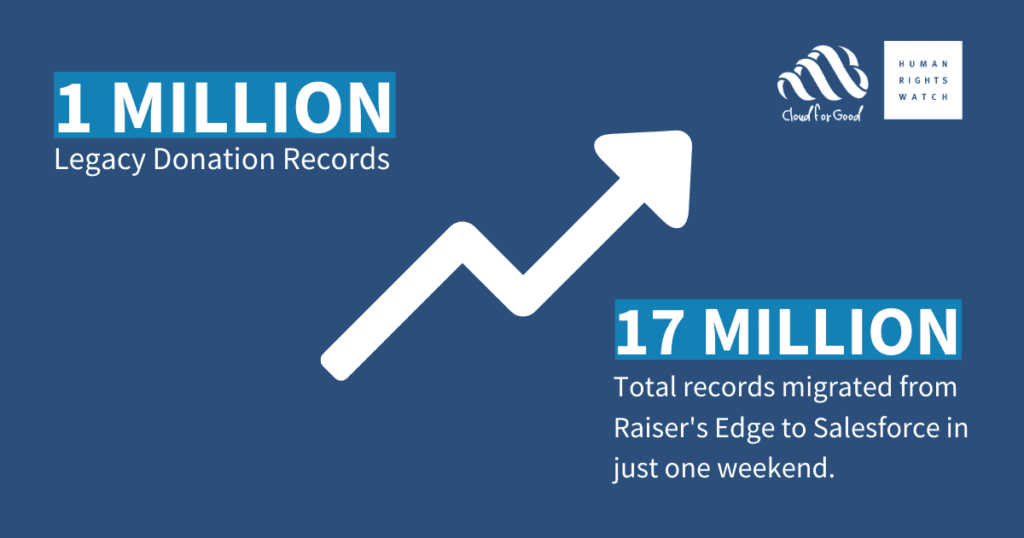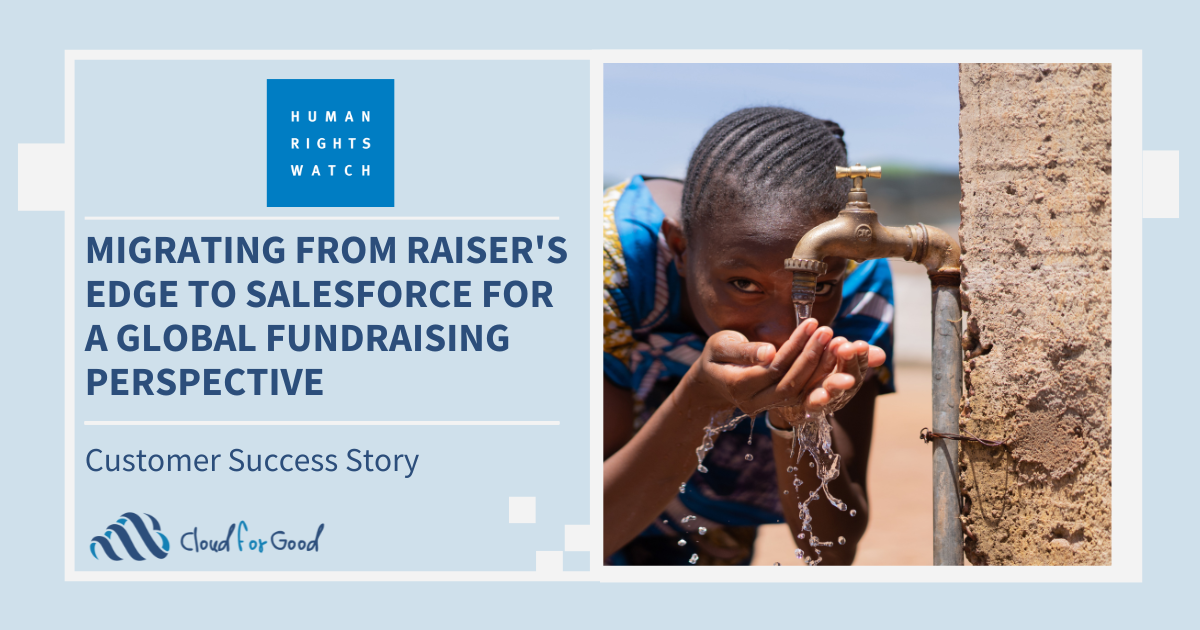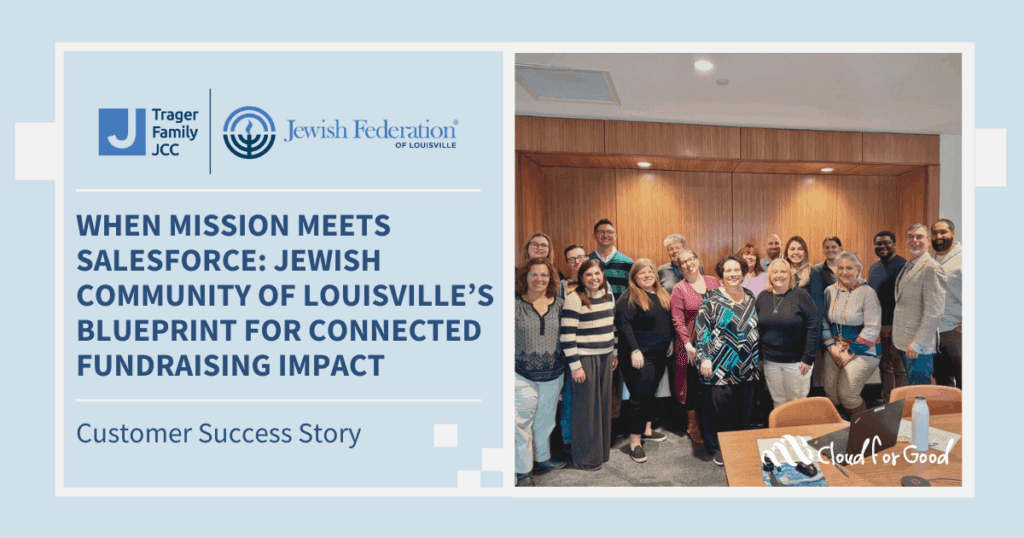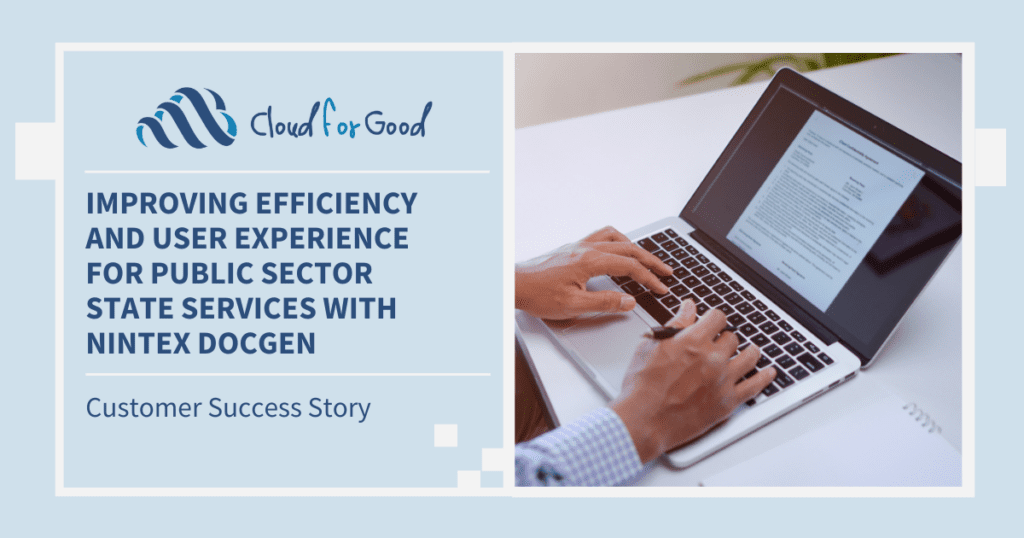In over 100 countries, Human Rights Watch investigates human rights abuses, exposes them for all to see, and seeks to create positive change in the lives of millions affected across the globe. A 450-person team representing 70+ distinct nationalities encapsulates the organization’s sweeping mission. Technology plays an inherently critical role in these humanitarian pursuits given the multi-currency, multi-lingual nature of Human Rights Watch’s efforts, and the organization has taken the necessary steps to ensure its tech solutions can adequately support the demands of those pursuits. In late 2019, Human Rights Watch established a strategic partnership with Cloud for Good in order to leverage Salesforce and evolve far past the limitations of their previous Raiser’s Edge system. This partnership extended beyond Raiser’s Edge to Marketing Cloud with Ad and Social Studio implementation as well as Cloud for Good’s Managed Services offering to ensure success on the platform.
Consolidating Systems + Eliminating Data Silos
The Nonprofit Cloud has provided Human Rights Watch with a system capable of scaling alongside its ever-increasing importance. Prior to Salesforce, the organization would seek out solutions to fit specific needs, using disconnected software that disjointed the organization’s departments rather than uniting them. Human Rights Watch CITO Walid Ayoub explains further, “If you needed fundraising management software, you would go out and find the software that could work for you. You would buy it and install it. If you need marketing software, you’d go in search of that. Then the challenge for IT becomes how to make those solutions talk to each other, to find a way to make them benefit from business intelligence and data. Things like data projection would be missed because our focus prior to Salesforce was on point solutions.”
This previous method of finding stop-gap solutions proved challenging for the Human Rights Watch IT team as they juggled the various solutions, all the while seeking to intelligently connect them all together. With business data strewn across disparate processes, the visibility into critical business functions, such as fundraising, constituent management, and account tracking, had become limited, preventing a single source of truth for Human Rights Watch’s data.

Your Guide to Migrating from Raiser’s Edge to Salesforce
Download the Your Guide to Migrating from Raiser’s Edge to Salesforce whitepaper to learn more about how to maximize your investment in your CRM implementation.
Building Atop the Salesforce Platform
Across a multi-phased implementation strategy, Cloud for Good worked closely with Human Rights Watch to help create a strategic roadmap that would move their organization from restrictive tools like Raiser’s Edge, Excel, and spreadsheet-tracking over to Salesforce, which would eliminate their data silos and transform their technology to help the organization raise more funds. This journey began with building a Salesforce solution for the organization’s fundraising operations, utilizing the Nonprofit Success Starter Pack and Cloud for Good’s proprietary Raiser’s Edge Migration Accelerator to seamlessly migrate years and years of fundraising data from the old system into the new. This resulted in over 1M legacy donation records and nearly 17M total records efficiently, and confidently, moved over from Raiser’s Edge to Salesforce in just one weekend.
One of the first steps taken by Cloud for Good in Human Rights Watch’s multi-phased Salesforce implementation involved an extensive review of the organization’s prospect/donor cycle. Taking a strategic consulting approach, the Cloud for Good team sat down with Human Rights Watch in order to intimately understand the organization’s fundraising methodology, from the identification of potential donors to the processes taken once a donor was identified or a donation was made. Cloud for Good then utilized this operational knowledge to specifically customize Salesforce for each step in the donor lifecycle, taking into account the different stages, sources, engagement plans, and events within that cycle. Once everything was integrated into Salesforce, tracking, forecasting, and visibility capabilities were drastically improved, adding a newfound level of efficiency and effectiveness to Human Rights Watch’s fundraising efforts.

A Culture of Collaboration + Stewardship
Part of Cloud for Good’s responsibility as a strategic partner is to ensure Human Rights Watch is properly enabled to use its new system to the fullest extent possible. The organization operates across 20 individual offices, but its headquarters are based in New York City. Ayoub took notice of Cloud for Good’s success as a 100% virtual company by stating, “The thing that drove me to Cloud for Good was how Tal Frankfurt set up the company as a distributed workforce. I felt if Cloud for Good was able to distribute their work that efficiently without a local office, that’s definitely going to help Human Rights Watch and our mission.”
The Cloud for Good team held over 30 hours of training for the Human Rights Watch teams through Zoom to prepare them for their new technologies, allowing organizational staff to grow more comfortable and confident within the new system at an accelerated rate.
Of course, as an international organization, the ability to manage the various languages, cultures, and time zones of their constituents and staff is incredibly important to Human Rights Watch. Unfortunately, the previous Raiser’s Edge system was far too rigid to accommodate such an expansive priority, limiting the Human Rights Watch fundraising team to essentially only enter gift data according to the United States dollar with minimal ability to enter in local currency. This, in turn, incurred a tremendous amount of manual processing involving currency conversions found within several, scattered spreadsheets. Human Rights Watch needed to centralize all gifts in one system and have the ability to enter those gifts with detailed breakdowns according to the local currency of each donor. With the single source of truth made possible with Salesforce, Human Rights Watch can do just that, all while utilizing automated currency conversions for a detailed look at donations on a local and global scale.
Prioritizing Privacy + Data Integrity
Human Rights Watch’s international nature also made privacy an absolute priority in its technology strategy. As such, Cloud for Good worked with the organization to restrict visibility within their systems to only those within a particular region. What this did was establish different sharing rules, according to permission sets and public groups, based on a constituent’s physical location. Salesforce also allowed Human Rights Watch to fully manage its own backup data, something simply not possible in the previous system. With the recent high-profile data breach of Blackbaud still reverberating within the nonprofit sector, the ability for Human Rights Watch to have complete control of their data and back-ups has never been more pertinent.
Streamlined Accounting Reconciliation
In order to continue pushing the strategic technology consolidation, Cloud for Good is helping Human Rights Watch create a bi-direction integration with their accounting software, Netsuite. This integration enables daily exchange rates to push into Salesforce, along with their yearly-set exchange rates, and automatically displays them in Salesforce. This enhanced reporting capability to gain a deeper understanding of their constituents and fundraising goals, as well as visibility into both local and US-based currency in one location aiding to the end-user experience. What was once a huge burden on the Human Rights Watch finance and accounting teams has become completely automatic through the Salesforce integration with Netsuite, saving countless hours of reconciliation.

Our Watch Has Only Just Begun
Though the Human Rights Watch Salesforce implementation journey has just begun, the underlying goal of the organization was to achieve a centralized view of their constituents and steward major gift-giving from their supporters. “In migrating to Salesforce, Human Rights Watch expects to reap benefits from greater efficiency across the processes of our global fundraising team by streamlining tasks and consolidation of all our data into a system we will be able to analyze,” reflected the Director of Development Operations Lesley Washington. On Cloud for Good’s partnership during this implementation journey, Washington continued to say “Cloud for Good has completely met and in many areas exceeded expectations. Through the process, I felt Cloud for Good has maintained a focus on partnership and I always felt their goal was finding the best solution for us. I told them from the beginning I wanted a strong partner I could trust, lean on, and learn from, and that is the experience I’ve had.”
Through strategic consulting and partnership with the Cloud for Good team, Human Rights Watch has been able to dramatically affect its business model, its user adoption, and its change management. And they’re only getting started: a Marketing Cloud implementation, Social Studio integration, and a custom-built Operations Entities Database are all well underway for Human Rights Watch, setting them up for continued evolution of their technology that will grow alongside the organization. Thus, allowing Human Rights Watch to defend rights and secure justice with both compassion and technology.
In closing, Ayoub says, “Cloud for Good helped us improve our fundraising operations. Cloud for Good is more than a vendor for us, they are a partner that allows us to achieve our mission and, especially in the turbulent year of 2020, has been a true difference-maker for Human Rights Watch.”
For more information on Human Rights Watch, visit hrw.org.





